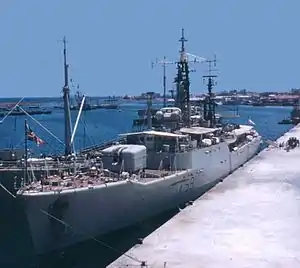HMS Chichester (F59)
HMS Chichester was a Salisbury-class or Type 61 aircraft direction frigate of the British Royal Navy.
 HMS Chichester at Famagusta, 1960 | |
| History | |
|---|---|
| Name: | HMS Chichester |
| Ordered: | 28 June 1951 |
| Builder: | Fairfields |
| Laid down: | 26 June 1953 |
| Launched: | 21 April 1955 |
| Commissioned: | 16 May 1958 |
| Identification: | Pennant number F59 |
| Fate: | Sold for breaking 17 March 1981 |
| General characteristics | |
| Class and type: | Salisbury-class frigate |
| Displacement: |
|
| Length: | 340 ft (100 m) o/a |
| Beam: | 40 ft (12 m) |
| Draught: | 15 ft 6 in (4.72 m) |
| Propulsion: | 8 × ASR1 diesels, 12,400 shp (9,200 kW), 2 shafts |
| Speed: | 24 kn (44 km/h) |
| Range: | 7,500 nmi (13,900 km) at 16 kn (30 km/h) |
| Complement: | 235 |
| Sensors and processing systems: |
|
| Armament: |
|
Service
Chichester was first commissioned in 1958 and in that year rescued crew of the coaster Concha off Milford Haven before the ship sank.[1] The commission took her through the Mediterranean to the Far East returning via South Africa and South America. In 1963/4 she was refitted in Chatham with macks (masts and stacks) along with type 965 & 993 radar. In 1968 she deployed for Fishery Protection duties and was accused by the Soviet Union of spying on Soviet naval exercises.[2]
.jpg.webp)
Towards the end of her career, in 1971 the Type 61 frigate was refitted as a Hong Kong guard ship, to replace an ageing Type 12 frigate, due in part to her good range conferred by her diesel machinery. Her radar fit was reduced to radar 978, 993M and the 275, Mk 6 director for the twin 4.5 and a more suitable light arms for patrol off Hong Kong of a 2 single 20mm guns and a 1 X 40mm Bofors.[3]
The election of the Labour Government in 1974 saw a further reduction of naval forces, east of Suez with the frigate being supplemented by five Ton Class minesweepers converted for Patrol duties, as the largest vessels maintaining a presence for protection of British interests. Chichester left Hong Kong in the spring of 1976 to return to the UK.
Following decommissioning Chichester arrived for scrapping at Queenborough on 17 March 1981.[4]
References
- Mason, Geoffrey B. (2007). "Chronology, Part 2 - 1951-60". naval-history.net. Retrieved 24 May 2015.
- Mason, Geoffrey B. (2007). "Chronology, Part 3 - 1961-70". naval-history.net. Retrieved 24 May 2015.
- Marriott, Leo (1983). Royal Navy Frigates 1945-1983 (1st ed.). Shepperton UK: Ian Allan. pp. 50–1.
- "HMS Chicester". Clydebuilt Database. Archived from the original on 9 December 2014. Retrieved 24 May 2015.CS1 maint: unfit URL (link)
Publications
- Colledge, J. J.; Warlow, Ben (2006) [1969]. Ships of the Royal Navy: The Complete Record of all Fighting Ships of the Royal Navy (Rev. ed.). London: Chatham Publishing. ISBN 978-1-86176-281-8.
- Marriott, Leo (1983). Royal Navy Frigates 1945–1983. Shepperton, UK: Ian Allan. ISBN 0-7110-1322-5.